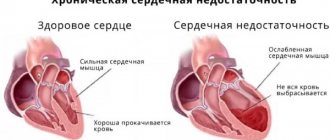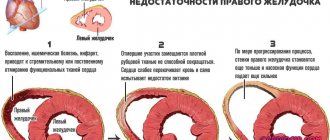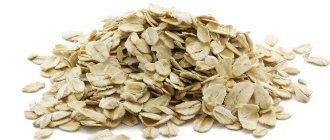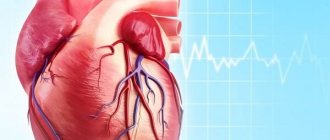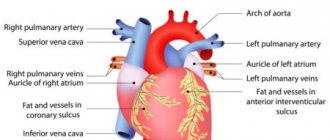The cardiovascular system plays a critical role in the functioning of the entire body. It ensures the transport of nutrients and oxygen to tissues and organs.
Diseases of the heart and blood vessels without timely treatment gradually move into the stage of decompensation. The heart becomes weak and loses its ability to fully pump the required volume of blood through the vessels. Because of this, the pressure in heart failure becomes low. If special supportive therapy is not carried out, this condition will ultimately lead to systemic hypoxia and death.
Heart disease is widespread among the population
What is the essence of SN?
Dysfunction of the cardiovascular system occurs due to damage to heart tissue, especially the myocardium. Along with it, the conduction system of the heart suffers, nerve impulses have difficulty reaching muscle fibers, the rhythm becomes irregular, the frequency and efficiency of contractions decreases.
The movement of blood through the vessels becomes difficult. At the beginning of this process, compensation mechanisms are activated - the muscle layer hypertrophies in order to fully meet the body's needs and maintain normal pressure in the blood vessels. For some time, the heart works at its maximum capacity, but then energy reserves run out, the heart chambers increase in volume, and the myocardium stretches and thins.
Systolic dysfunction occurs when the inotropic function of the heart fades, and then diastolic dysfunction quickly develops, the meaning of which is that the increased volumes of the cavities of the heart accommodate more blood under high pressure.
Both of these compensatory mechanisms are switched off, the pressure drops, arterial blood does not reach the peripheral parts of the vessels, and full gas exchange does not occur. An increased amount of carbon dioxide and other metabolic products accumulate in the tissues. Because of this, a pH shift occurs to the acidic side.
Changes in the acid-base balance disrupt the functioning of enzymes and other biologically active substances in the body, which further impairs the nutrition of cardiac tissue and leads to multiple organ failure.
The essence of heart failure
Forms of the disease
Doctors distinguish two forms of deficiency. The acute form of heart failure develops with sudden damage to the myocardium and a sharp decrease in contractility. This often happens when the blood supply to the heart tissue is disrupted and an area of necrosis (infarction) occurs. In this case, the pumping function suffers, the body lacks oxygen - hypoxia develops. The heart is not able to push blood out with the proper force, so a deficiency of arterial blood and stagnation of venous blood occurs, vascular tone and blood pressure decrease.
The chronic form of heart failure does not occur immediately. It takes a long time to form, sometimes whole years pass before symptoms of cardiac dysfunction appear. The cause of this condition is an increase in the load on the heart, as happens with chronic hypertension.
Sodium and water retention, lipid metabolism disorders and atherosclerosis cause the heart to beat faster and with greater force in order to maintain normal blood circulation in the human body. Hypertrophy of the heart muscle occurs, followed by dilatation and left ventricular failure.
Important! The process of formation of CHF is inevitable; this condition progresses over time, especially if there is no adequate treatment and lifestyle correction.
Stages of CHF
There are several classifications that describe the stages of development of chronic heart failure in adults. The most common classification is Strazhesko N.D. Depending on the results of the general examination and physical examination of the patient, the following stages are distinguished:
- Stage I - the onset of failure is characterized by the fact that clinical manifestations in the form of difficulty breathing, shortness of breath and strong heartbeat occur only during physical activity that was previously tolerated by a person normally. The rest of the time, health and performance are not impaired;
- Stage II is divided into two periods:
- Stage IIA – shortness of breath, dry cough, interruptions in heart function occur with moderate physical activity. This indicates the onset of blood stagnation in the pulmonary circulation and significantly reduces the patients’ ability to work;
- Stage IIB – symptoms of the pathological condition occur with minimal exertion and even at rest. Shortness of breath and cough intensify, hemoptysis may occur, and the skin becomes bluish. Patients are often bothered by pain in the heart area and swelling of the lower extremities. On palpation of the abdominal cavity, an enlarged dense liver is determined, and moist rales are heard in the lungs. Accumulation of free fluid in the chest and abdominal cavity is characteristic. The daily volume of urine is reduced. Patients with the disease at this stage are unable to work; the ability to self-care is somewhat preserved;
- Stage III – final or dystrophic. The clinical picture of hemodynamic disorders is clearly expressed. Symptoms that are characteristic of the previous stages become even more intense. Irreversible organic changes occur in internal organs. In the lungs and liver, dense connective tissue grows in place of dead cells, the blood supply to the kidneys is disrupted, and the outflow of venous blood is obstructed. Patients lose the ability to do anything independently, practically do not move in bed and are extremely exhausted. Treatment of pathology at this stage is ineffective.
Dilation of the heart chambers
Causes of the disease
Insufficiency may occur due to the following conditions:
- hypertensive crisis;
- myocardial infarction;
- uncontrolled hypertension;
- atherosclerosis of the coronary arteries and large vessels of the body;
- congenital and acquired defects;
- cardiac tamponade, hemopericardium;
- rhythm disturbance;
- kidney disease in the stage of decompensation;
- inflammatory diseases of the myocardium;
- chronic lung diseases;
- pulmonary embolism;
- psycho-emotional stress;
- diseases of the endocrine system, in particular diabetes mellitus and hyperthyroidism;
- severe infectious diseases accompanied by fever;
- anemia;
- poisoning with toxic substances and overdose of certain medications;
- alcoholism, drug addiction, smoking.
Note! One of the main reasons that leads to heart failure in adults is excess body weight.
How to raise low “heart” pressure at home?
Diseases of the cardiovascular system are the most common and pose a serious danger. One of the indicators of the functioning of the heart muscle in accordance with the norm is blood pressure. Low heart pressure is a sign indicating the presence of disturbances in the functioning of the circulatory system, as well as the nervous and endocrine systems associated with it.
This is a danger signal that should be responded to in a timely manner in order to prevent the occurrence of chronic diseases. Let's look at what symptoms may indicate low heart pressure, its causes and consequences.
Symptoms of the disease
Changes in hemodynamics throughout the body provoke the occurrence of the following symptoms:
- Difficulty breathing, lack of air, shortness of breath during physical activity and then at rest;
- Orthopnea is the inability to take a supine position; to facilitate breathing, the patient is forced to sleep while sitting;
- Night attacks of shortness of breath and cough with hemoptysis due to overload of the heart and pulmonary vessels with blood, which flows from the veins of the lower extremities when the body is in a horizontal position;
- General weakness, fatigue, insomnia, confusion and memory impairment;
- Pale skin and increased sweating;
- Decrease in systolic blood pressure;
- Decreased volume of urine excreted during the day. Night diuresis, on the contrary, increases, since in the lying position the blood supply to the kidneys improves;
- Heaviness, periodic dull pain in the right hypochondrium due to congestion of the liver and stretching of its capsule;
- Swelling of the veins and swelling of the lower extremities, which decrease after a night's rest;
- Possible formation of free fluid in the abdominal cavity (ascites) and in the chest (hydrothorax).
Man in orthopneic position
Rehabilitation for chronic heart failure
Enter your pressure
130
on
90
Search in progress Not found
Circulatory failure is not a specific disease, but a complex of symptoms that occurs with heart valve defects, myocardial damage, and arrhythmias. In case of heart failure, the stroke and minute volumes of the heart decrease, the pulse quickens, arterial pressure decreases and venous pressure increases, blood flow slows down, swelling, cyanosis, and shortness of breath appear.
There are three stages of chronic heart failure
At stage I, at rest and during normal work and household loads, there are no signs of circulatory disorders. With increased stress, shortness of breath occurs, the pulse quickens and a feeling of fatigue appears, sometimes swelling in the legs appears in the evening. Exercise therapy in the first half of the course of treatment is aimed at stimulating extracardiac circulatory factors. In the second half, the loads gradually increase from 50% of the threshold power to 75-80% in order to train the heart muscle. Class density is increased from 40-50 to 60-70%. All starting positions, exercises with objects, apparatus, and on apparatus are used. Include exercises to develop strength, sedentary games, and walking. Lesson duration: 25-30 minutes.
Stage II is characterized by signs of insufficiency at rest. At stage IIa, the liver enlarges, congestion in the lungs, and moderate swelling in the legs are detected. In case of circulatory failure Pa stage, therapeutic exercises increase the effect of medications. General strengthening exercises are used in alternation with static breathing exercises, at a slow pace, at the beginning of the course of treatment - in a lying position, later - sitting and standing, at an average pace, with a decrease in breathing exercises in the ward mode, walking is added. Lesson duration: 10-15 minutes. Stage II b is characterized by a significant enlargement of the liver, pronounced edema, shortness of breath and rapid heartbeat occur with minor movements. Such patients in the hospital are on extended bed rest. In case of circulatory failure stage II b, exercises are used for small and medium muscle groups, passive, active with help at a slow pace. Lesson duration: 10-12 minutes, 2-3 times a day.
At stage III of chronic heart failure, congestion with accumulation of fluid (ascites) in the serous cavities and persistent changes in the heart, liver, kidneys and other organs are significantly pronounced. Therapeutic exercises are contraindicated.
Physical performance is reduced from 350-450 kgm/min in stage I to almost complete absence in stage III.
Diagnosis of the disease
Diagnosis of the disease includes several sequential methods that allow you to study the condition of the body in detail, most accurately establish the diagnosis and determine the stage of the disease. The list of diagnostic measures includes:
- general examination;
- palpation and percussion of the heart, lungs, liver, lower extremities;
- electrocardiography;
- chest x-ray;
- echocardiography with Doppler examination of blood vessels;
- laboratory testing of blood and urine.
Treatment methods
When low blood pressure occurs due to heart failure, what should you do? First of all, consult a doctor immediately. After a comprehensive examination, a treatment plan is drawn up. Therapy should be comprehensive and be aimed at:
- identification and treatment of the disease that caused HF;
- compliance with the diet - it is advisable to reduce salt and liquid intake;
- optimization of physical activity in the amount recommended by a rehabilitation physician;
- removal of excess water using diuretics in tablets or solutions;
- an increase in cardiac output and in order to increase blood pressure - doctors prescribe inotropic drugs;
- improving blood supply to internal organs with the help of vasodilator tablets;
- improvement of metabolism in tissues, which is realized through the additional administration of medications with electrolytes and nutrients, for example, glucose.
Drugs prescribed for heart failure and hypertension can reduce the symptoms of the disease, but surgical treatment is recognized as the most effective. Its meaning is heart transplantation. Several thousand such operations are performed annually, but the number of patients who need such treatment significantly exceeds the number of donors. That is why HF still occupies a leading position among the causes of mortality in the population.
Heart transplant
Despite the fact that there are effective methods for treating and correcting heart failure, doctors cannot quickly and radically solve this problem, especially in the later stages. It is important to promptly suspect and identify the disease in order to effectively control it and improve the quality of life of cardiac patients
Video on the topic of the article:
Healthy lifestyle
3. A decrease in blood pressure can also provoke heart failure. So, you have low blood pressure: what to do in this situation? My mother has constantly low heart pressure. Also, low heart pressure is a companion to diseases associated with impaired nervous regulation of the heart. This symptom is caused by certain disturbances in the functioning of the heart organ, which arise as a result of low pressure.
Low blood pressure is referred to in medicine by the term “hypotension”, but scientifically it sounds like arterial hypotension. True, in this case, an increase in pressure to 120/80 is very problematic for them.
In addition, the weakness hormone acetylcholine is also produced, which, on the contrary, lowers blood pressure, causing chills, cold sweats, a feeling of weakness, melancholy and weakness. Thus, pressure surges are observed. 5. A decrease in blood pressure can be caused by some medication. 7. Even healthy people can sometimes experience low blood pressure. 5. If your blood pressure drops in the morning, then you should drink 25 - 30 drops of cordiamine and 1 tsp. tinctures of Chinese lemongrass.


